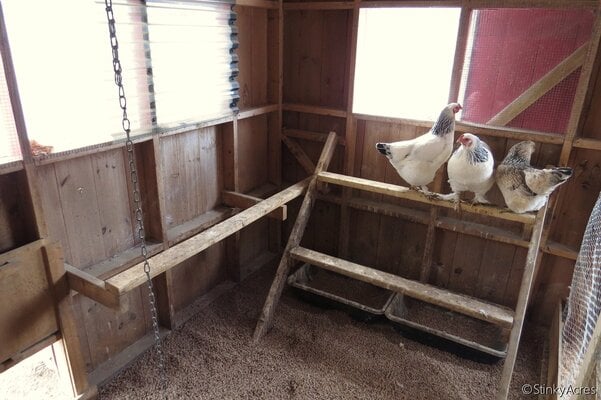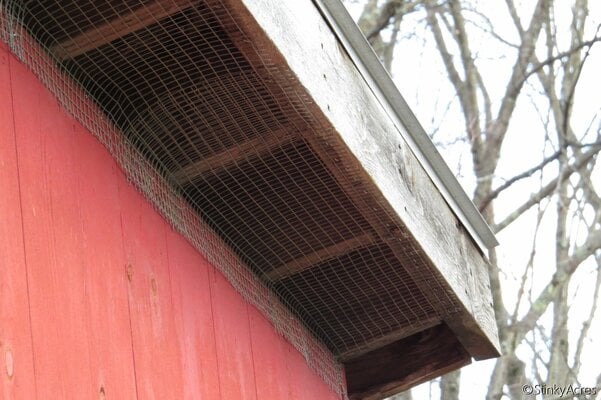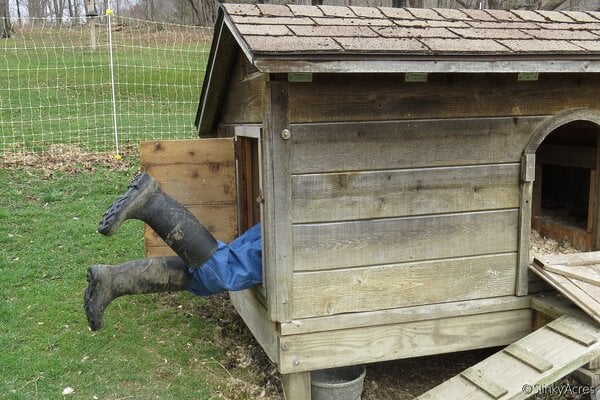So you are looking to buy or build a new chicken coop and are wondering what size you need. Everyone talks about floor space, but what about ceiling height?
If you have ever browsed farm stores, the internet, or even your neighborhood for chicken coops you will find that many, maybe even the majority, are only a few feet tall. It would lead one to believe that a chicken coop only needs to be chicken-sized. While a short coop might work for some, most chicken keepers will need more than those little coops have to offer.
I myself have an elevated coop with a short ceiling, but I also have a large walk-in coop and it has become clear to me the taller coop has its advantages. So if you are asking, “Why do animals that are only 12 to 24 inches tall need a 7-foot-tall coop?” this article will explain some reasons why a taller coop is often a much better option than a short one.
1. Cleanliness
Most chickens prefer to sleep on an elevated perch. It is their instinct to find the highest place they can reach to roost at night. Chickens also poop (a lot!) while they roost. Roosting bars placed above the height of the nesting boxes will discourage the chickens from roosting in the nesting boxes and, thus, keep the nesting boxes and the eggs cleaner. Roosting bars placed well above the floor also keep the chickens from sleeping in their own poop which keeps their feathers cleaner and reduces the risk of fly strike.
At the very least, the height of the coop should allow for the height of the nesting boxes and a roosting space above that.

An elevated roost keeps the chickens cleaner and happier
2. Ventilation
Adequate coop ventilation and air circulation is important, even during freezing temperatures. Chickens and their droppings release moisture and ammonia, and if you keep water in the coop it too will evaporate into the air. Allowing this moisture and gas to escape and fresh air to enter into the coop promotes a healthier environment within the coop and reduces the risk of frostbite and respiratory illnesses.
Windows are great but usually only for temporary ventilation during the warmer months, warmth during the cooler months, and natural light. What if there is a storm and you need to close the windows to keep the cold wind, rain, and snow off of your birds? That’s why it is recommended to install permanent, protected vents in a chicken coop in addition to windows. Under the roof overhangs is the ideal spot for permanent ventilation. Warm, moist air rises so the height will allow it to escape and the roof overhangs can shield the vents and keep precipitation out of the coop. The higher and farther away the vents are from the chickens while they roost the better; far enough that cold drafts cannot hit them and ruffle their insulating feathers.
Most small prefab coops you'll find at the farm store do not provide enough ventilation nor do they have the wall space or enough of a roof overhang to add more, so significant modifications often have to be made in order to make one into an acceptable chicken coop.

Soffit vents are a great choice for permanent ventilation
3. Accessibility for the keeper
Why do we humans need to be able to fit in the chicken coop? Well, imagine you have a coop only big enough for chickens and one of your hens lays an egg in a corner of the coop outside the nesting boxes. Or maybe you find one of your chickens is sick and is sitting motionless in the coop. How are you going to get them out? Several doors and a hinged roof can help, but you’ll probably either be crawling in chicken poop or exposing the inside of the coop to the weather in order to get to them.
It is so much easier to properly tend to your flock in a walk-in coop! One of the best times to examine chickens is at night when they are calm and roosting. In a walk-in coop you can easily check on your birds, treat sick birds, separate or move birds, collect eggs, and clean the coop all under a roof and out of the weather.
This also applies to the run. Believe me, it’s no fun bending over in the run to catch chickens, collect eggs, or maintain the run!

Short coops can be inconvenient
Other benefits
Other benefits of a taller coop include the ability to use the deep bedding or deep litter methods (described HERE) and extra storage space. And if one decides to give up chicken keeping, a walk-in coop can be converted into a garden or storage shed fairly easily.
When is a taller coop not necessary?
While I believe everyone can benefit from a walk-in coop, there are a few situations where one may not be needed. Smaller, shorter coops are usually sufficient for those who only plan on keeping a small flock of flightless breeds, such as Silkies. They are also more convenient to move regularly if the keeper so wishes. Those who only plan to use the coop during the summer or those in warm climates may not have to worry about vent placement and cold drafts. And if a coop is placed underneath a roofed structure, such as inside a roofed run or barn, there should be no problem accessing the inside of a short coop through a hinged top in inclement weather.
Conclusion
The height of a chicken coop is not often discussed but it is more important than many realize. I hope this article helps you understand how a taller coop can not only make it easier for you to tend to your chickens, but also help you raise healthier chickens and keep their eggs cleaner.
